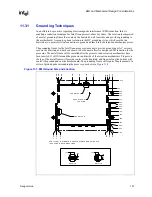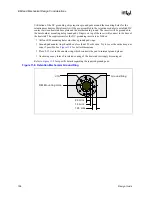
Design Guide
149
EMI and Mechanical Design Considerations
EMI and Mechanical Design
Considerations
11
11.1
Introduction
As microprocessor amperage and speeds increase, the ability to contain the corresponding
electromagnetic radiation becomes more difficult. Frequencies generated by these processors will
be in the low gigahertz (GHz) range, which will impact both the system design and the
electromagnetic interference (EMI) test methodology.
This section is intended to provide electrical and mechanical design engineers with information
that will aid in developing a platform that will meet government EMI regulations. Heatsink
grounding, processor shielding, differential and spread spectrum clocking, and the test
methodology impact to FCC Class B requirements are specifically discussed.
Designers should be aware that implementing all the recommendations in this guideline will not
guarantee compliance to EMI regulations. Rather, these guidelines may help to reduce the
emissions from processors and motherboards and make chassis design easier.
11.1.1
Brief EMI Theory
Electromagnetic energy transfer can be viewed in four ways: radiated emissions, radiated
susceptibility, conducted emissions, and conducted susceptibility. For system designers, reduction
of radiated and conducted emissions is the way to achieve EMC compliance. Susceptibility is
typically not a major concern in the server environment, although it may be more important in an
industrial environment.
The main component of EMI is a radiated electromagnetic wave, which consists of both electric
(E-fields), and magnetic (H-fields) waves traveling together and oriented perpendicular to one
another. Although E- and H-fields are intimately tied together, they are generated by different
sources. E-fields are created by voltage potentials, while H-fields are created by current flow. In a
steady state environment (where voltage or current is unchanging), E- and H-fields are also static
and of no concern to EMI. Changing voltages and currents are of concern since they contribute to
EMI. If a dynamic E-field is present, then there must be a corresponding dynamic H-field, and vice
versa. Motherboards with fast processors generate high frequency E- and H-fields from currents
and voltages present in the component silicon and signal traces.
Two methods exist for minimizing E- and H-field system emissions: prevention, and containment.
Prevention is achieved by implementing design techniques that minimize the ability of the
motherboard to generate EMI fields. Containment is used in a chassis environment to contain
radiated energy within the chassis. Careful consideration of board layout, trace routing, and
grounding may significantly reduce a motherboard’s radiated emissions and make the chassis
design easier.
Summary of Contents for Xeon
Page 24: ...Introduction 24 Design Guide This page is intentionally left blank ...
Page 30: ...Component Quadrant Layout 30 Design Guide This page is intentionally left blank ...
Page 52: ...Platform Clock Routing Guidelines 52 Design Guide This page is intentionally left blank ...
Page 66: ...System Bus Routing Guidelines 66 Design Guide This page is intentionally left blank ...
Page 118: ...Intel 82870P2 P64H2 118 Design Guide This page is intentionally left blank ...
Page 146: ...I O Controller Hub 146 Design Guide This page is intentionally left blank ...
Page 148: ...Debug Port 148 Design Guide This page is intentionally left blank ...
Page 210: ...Schematic Checklist 210 Design Guide This page is intentionally left blank ...
Page 220: ...Layout Checklist 220 Design Guide This page is intentionally left blank ...
Page 222: ...Schematics 222 Design Guide This page is intentionally left blank ...















































